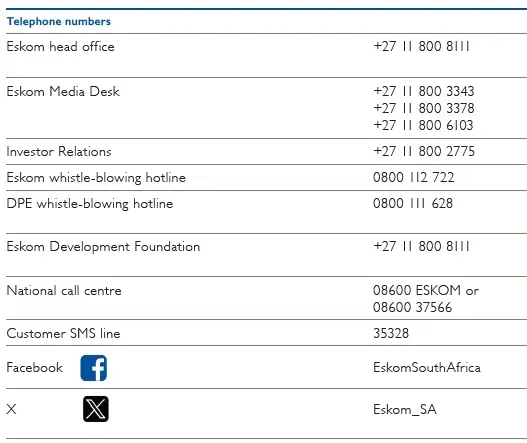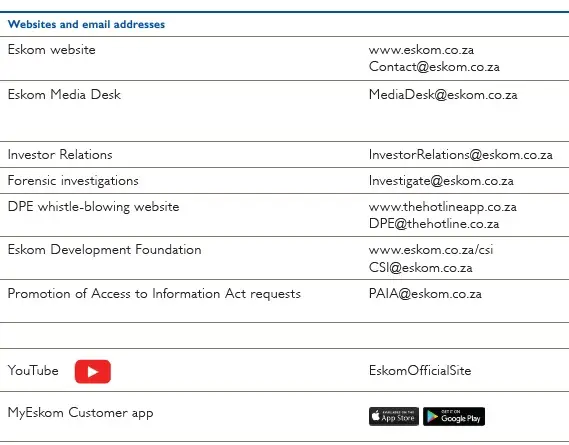Eskom Hld SOC Ltd or Eskom is a South African electricity public utility. Eskom was established in 1923 as the Electricity Supply Commission (ESCOM). Eskom represents South Africa in the Southern African Power Pool. The utility is the largest producer of electricity in Africa, and was among the top utilities in the world in terms of generation capacity and sales.
- What are the main power stations operated by Eskom?
- Why is Eskom implementing load reduction?
- What are the current challenges faced by Eskom?
- Is Eskom currently load-shedding?
- How do I report Eskom fault?
- How much debt does Eskom have?
- How do I find load shedding in my area?
- How long does load shedding last?
Eskom’s mandate, is to lower the cost of doing business in South Africa, enabling economic growth, and providing electricity in an efficient and sustainable manner. The mandate is informed by the Department of Public Enterprises (DPE), which outlines the Shareholder’s expectations of Eskom over the planning horizon.
The vision and mission were developed to support the mandate.
Eskom creates value through the generation, transmission, distribution, purchase, and sale of electricity. Its value creation model below depicts how it transforms inputs into electricity supplied to customers. Electricity is generated by transforming inputs from the natural environment, such as coal, nuclear fuel, fuel oil, and diesel, as well as water and wind, into electricity. This energy is transmitted over Eskom’s ~33 000km of network in which the supply and demand of electricity are balanced in real time, maintaining the frequency of the power system at 50 hertz (Hz). The electricity is distributed through an extensive distribution network that covers the entire country to supply over 86% of South Africa’s needs and ~20% of the electricity produced in Africa.
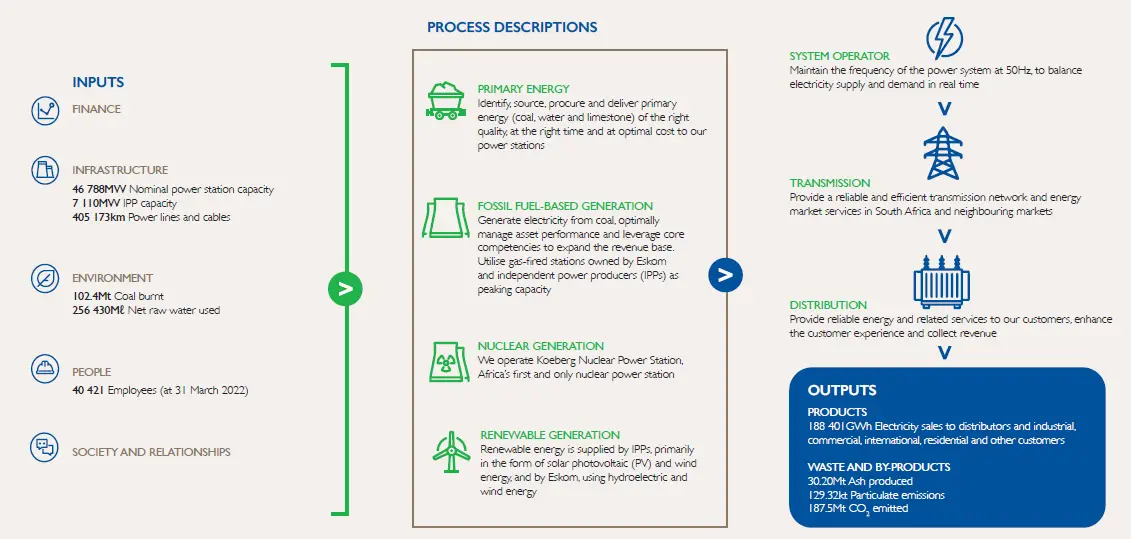
Operating structure
Eskom Holdings SOC Ltd is a state-owned company (SOC) as defined in the Companies Act, 2008 and is wholly owned by the South African Government. The Department of Public Enterprises as the Shareholder Ministry sets our mandate and outlines the expectations from government through the Strategic Intent Statement (SIS) and the Shareholder’s Compact (SHC). As a state-owned entity, Eskom also plays a significant developmental role in support of the National Development Plan 2030 (NDP), by supporting job creation, economic and skills development, broad-based black economic empowerment
(B-BBEE), transformation and other national initiatives.
The Department of Mineral Resources and Energy (DMRE) is responsible for energy policy. Key documents like the Integrated Resource Plan (IRP), the Electricity Regulation Act (ERA) and the Electricity Pricing Policy (EPP) are instruments that outline the direction of the electricity sector in which Eskom operates.
The National Energy Regulator of South Africa (NERSA) regulates the industry under the National Energy Regulator Act, 2004 and the Electricity Regulation Act, 2006 by providing licences, regulatory rules, codes, and guidelines. NERSA also determines Eskom’s revenue allocation in accordance with the Electricity Pricing Policy (EPP).
The National Nuclear Regulator (NNR) provides oversight of our nuclear power station, Koeberg, by ensuring that it complies with nuclear safety standards to protect individuals, society and the environment against radiological hazards linked to the use of nuclear technology. Eskom is also subject to oversight or regulation by several other government departments (e.g., National Treasury (NT), Ministry of Electricity (MoE), Department of Forestry, Fisheries, and the Environment (DFFE)), and Parliamentary committees.
Eskom’s core divisions, Generation, Transmission and Distribution, rely on corporate support functions to operate effectively. The main subsidiary, Eskom Rotek Industries, performs turbine and transformer subsidiary repairs and provides specialised construction and transport services, in support of the electricity business, while other subsidiaries also provide strategic support services.
The figure below provides Eskom’s high-level organisational and regulatory structure.
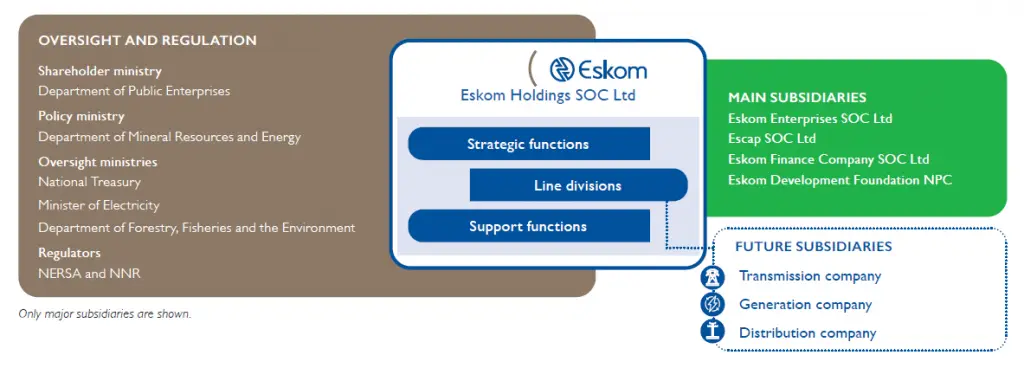
Eskom transforms inputs from the natural environment – coal, nuclear, fuel, diesel, water, and wind – into more than 90% of the energy supplied to a wide range of customers in South Africa and the Southern African Development Community (SADC) region. To balance electricity supply and demand in real time, the System Operator (soon to be the Independent Transmission and System Market Operator, ITSMO, as the Transmission business continues to legally separate) must maintain the frequency of the power system at 50Hz.
Eskom is one of the few remaining vertically integrated utilities connected to the Southern African Power Pool (SAPP) through an interconnected grid, which serves to support grid stability. Eskom relies on SADC members to maintain sufficient and reliable transmission grids in their countries.
The foundation of the business is the generation, transmission, distribution, and sale of electricity, supplemented with the construction of new power stations and network infrastructure. The Gx, Tx, and Dx Divisions rely on support in the form of finance, human resources, procurement, information technology, telecommunications, strategy, risk and sustainability, legal and compliance, and stakeholder relations. In support of the electricity business, Eskom Rotek Industries (a subsidiary) performs turbine and transformer repairs and provides specialised construction and transport services.
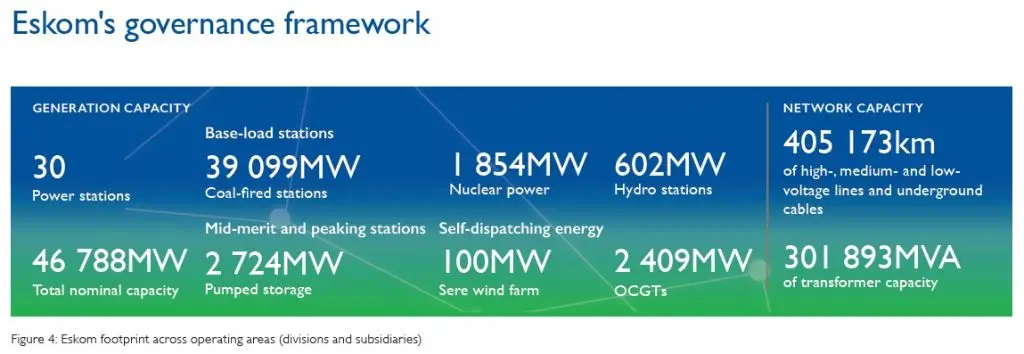
STRATEGIC INTENT STATEMENT
As a state-owned entity, Eskom must implement government policy and strategy. The Shareholder’s Strategic Intent Statement (SIS) outlines government’s short-to-medium-term and long-term objectives for Eskom to achieve. Eskom has adopted these SIS objectives to ensure that Eskom remains a critical and strategic contributor to government’s goal of ensuring security of electricity supply to the country, and enabling economic growth and prosperity.
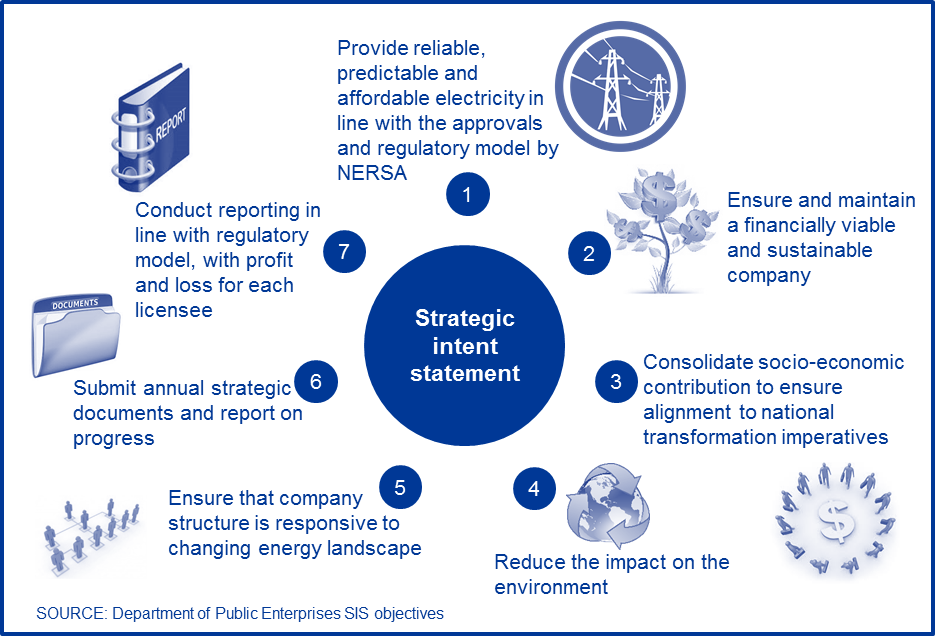
Eskom Holdings SOC Ltd has the Government of the Republic of South Africa as its sole shareholder, with the shareholder representative being the Minister of Public Enterprises. As a public entity, it is governed by the provisions of the Public Finance Management Act 1 of 1999 (PFMA). The PFMA requires a company to conclude a shareholder compact with the shareholder representative. The shareholder compact has to contain shareholder expectations in the form of predetermined objectives and key performance indicators and ensures alignment between the Board and the shareholder representative. In addition, the PFMA requires that a company submit a strategic corporate plan to the shareholder on an annual basis, setting out its strategic objectives, with plans and targets to achieve those objectives.
The governance framework, which regulates Eskom’s relationship with its Shareholder (the Government of the Republic of South Africa) and guides the way Eskom does business, is set out in the figure below:

If you have completed an application form for a service from Eskom, and you have sent your form to the relevant e mail address with the relevant hashtag and province in the subject line eg #Applications Western Cape, Eskom will notify you, via sms, of the milestones reached in your application.
EasternCape@eskom.co.za
FreeState@eskom.co.za
Gauteng@eskom.co.za
KwaZuluNatal@eskom.co.za
Limpopo@eskom.co.za
Mpumalanga@eskom.co.za
NorthernCape@eskom.co.za
NorthWest@eskom.co.za
WesternCape@eskom.co.za
Please ensure that your email has the relevant email subject heading as follows:
- For Applications related queries, please use #Application and the Province your request relates to.
- For Move In / Move Out related queries, please use #MIMO and the Province your request relates to.
- For Accounts related queries, please use #Accounts and the Province your request relates to.
- For Disconnections and Credit Extensions, please use #DCE and the Province your request relates to.
- In order for us to effectively assist you, please provide us with your account or meter number, two contact numbers and a description of your request.
- For customer complaints click here
Contact Information
In addition to the South Dunes Coal Terminal and Golang Coal companies in Richards Bay harbour in South Africa, other enterprises include:
Eskom Rotek Industries
Eskom Rotek Industries, the largest of the enterprises in the Eskom Enterprises stable, was established to construct, maintain and transport equipment to support Eskom to meet and exceed South Africa’s electricity needs.
Click here for the Rotek Industries website
National Transmission Company South Africa
The National Transmission Compnay South Africa (NTCSA) owns and operates the country’s national transmission system, the world-class System Operator, the grid strengthening function, energy market services and the International Trader.
In terms of current legislation, NTCSA plays the role of the Transmission System Operator and buyer. It will assume additional roles once the Electricity Regulation Amendment (ERA) Bill is passed into law. The NTCSA will trade with Eskom Generation and Independent Power Producers (IPPs) using the current industry framework. The transition to a competitive electricity market will only commence after the ERA is gazetted, and NTCSA will assume the additional role of Market Operator. In this capacity, it will provide a platform for generators, consumers, traders, and retailers to trade with one another, as is the case in leading countries around the world.
The establishment of the NTCSA is another step in the electricity market structure reform, aiming to enhance efficiency and promote transparency. It will act as a catalyst for much-needed improvements and upgrades within the national electricity transmission infrastructure.
Click here for the NTCSA website
Eskom Uganda Limited
Eskom Uganda Limited prides itself on its expertise in electricity generation concession management in Uganda where it has been operating for the past 13 years. Experienced in hydro power generation and backed by the expertise of Eskom Enterprises, this concession is poised for growth – supporting Uganda’s vision to give 80% of the population access to electricity by 2040.
Click here for the Eskom Uganda Limited website
Trans-African Projects
Trans African Projects (TAP) specialises in effective design solutions for transmission and distribution projects with a footprint in mainly Africa, but reaching as far as the Middle East and China. Expertise focuses on substation design, renewable energy solutions, network studies, consulting engineering and project management. TAP has the unique ability to design ‘fit-forpurpose’ line solutions, making their line optimisation product well sought after.
Click here for the Trans-African Projects website
Need Information or Confused about Something ?
Ask a Question
Sponsored Guide
Complete Guide to NSFAS Online Loan Application for South African Students (2025)
If you are a South African student looking to pursue higher education but are facing financial difficulties, the National Student Financial Aid Scheme (NSFAS) is one of the most accessible funding options available. NSFAS provides financial aid in the form of bursaries and loans to qualifying students at public universities and TVET colleges in South Africa.
This guide will walk you through everything you need to know about the NSFAS loan application process, from eligibility requirements to application steps and frequently asked questions.
📌 What is NSFAS?
The National Student Financial Aid Scheme (NSFAS) is a government-funded financial aid scheme aimed at helping students from low- and middle-income households to access tertiary education without the burden of upfront fees.
NSFAS offers both bursaries and income-contingent loans:
- Bursaries: For eligible students who meet academic and household income criteria (especially for TVET and university students).
- Loans: For students who do not meet all bursary criteria or who are pursuing postgraduate qualifications not funded under bursary schemes.
✅ Who Qualifies for an NSFAS Loan?
To qualify for an NSFAS loan (especially for postgraduate students or programs not funded under the bursary system), you must:
- Be a South African citizen.
- Be financially needy, with a household income of less than R350,000 per year.
- Have a valid South African ID.
- Be enrolled or accepted to study at a public university or TVET college.
- Not be funded through another bursary program that covers all expenses.
- Maintain satisfactory academic progress (returning students).
📚 Courses Funded by NSFAS
NSFAS primarily funds undergraduate qualifications, but certain postgraduate programs (e.g., PGCE, postgraduate diplomas in education, and professional courses like LLB) may be considered under the NSFAS loan scheme, not bursaries.
If you’re studying:
- Undergraduate degree or diploma: You are likely eligible for a full NSFAS bursary.
- Postgraduate study: You may qualify for a loan, depending on the course and funding availability.
📄 Required Documents for NSFAS Application
When applying, make sure you have the following documents scanned and ready:
- Certified copy of your South African ID or Smart Card.
- Parent(s) or guardian(s) ID documents.
- Proof of income (latest payslips, UIF, or affidavit if unemployed).
- Consent Form signed by your parent(s)/guardian(s) to allow NSFAS to verify income.
- Proof of registration or acceptance at a public institution.
- Academic transcripts (for continuing or postgraduate students).
🖥️ How to Apply for an NSFAS Loan Online
Step-by-Step NSFAS Online Application Process (2025)
-
Visit the NSFAS Website
Go to: https://www.nsfas.org.za
-
Create an Account
- Click on “MyNSFAS” and register your profile.
- You’ll need a valid email address and South African cellphone number.
- Choose a strong password and verify your account via email or SMS.
-
Login and Start the Application
- After registration, log in to your MyNSFAS account.
- Click on “Apply” to begin a new application.
-
Fill in Your Personal Details
- Input your ID number, name, surname, and other details exactly as they appear on your ID.
- Provide household income information and living arrangements.
-
Upload Required Documents
- Upload all supporting documents in PDF or JPEG format.
- Each document must be clear and under the size limit specified.
-
Submit Your Application
- Review your application for accuracy.
- Click “Submit” and wait for a confirmation message.
-
Track Your Application
- Log in regularly to check your application status.
- You will be notified via SMS and email at each stage of the process.
🗓️ Important NSFAS Dates (2025)
- Application Opening Date: September 1, 2025
- Application Deadline: January 31, 2026
- Appeals Period: February 2026 (if rejected)
- Disbursement: After registration and approval
Note: Dates are subject to change; always confirm on the official NSFAS website.
💸 What Does the NSFAS Loan Cover?
NSFAS funding typically includes:
- Tuition fees
- Registration fees
- Accommodation (if living away from home)
- Meals and transport
- Learning materials (e.g., textbooks)
For loans, repayment is only required once you start working and earn above a threshold (around R30,000 annually, but subject to change).
🔄 NSFAS Loan Repayment
Repayments are:
- Income-contingent – you only repay when you can afford to.
- Administered by DHET (Department of Higher Education and Training).
- Interest-bearing, but interest rates are low and favorable.
You can also apply for a partial loan conversion to a bursary if you perform well academically.
🔁 How to Appeal a Rejected NSFAS Application
If your application is rejected, you may submit an appeal via your MyNSFAS portal:
- Log into your MyNSFAS account.
- Click on “Track Funding Progress”.
- If rejected, click on “Submit Appeal”.
- Upload any missing or corrected documents.
- Provide a clear explanation or motivation.
📱 NSFAS Contact Information
- Website: https://www.nsfas.org.za
- Email: info@nsfas.org.za
- Toll-Free Number: 08000 67327 (Monday–Friday, 8 AM–5 PM)
- Twitter: @myNSFAS
- Facebook: NSFAS
📝 Final Tips Before Applying
- Apply early to avoid system overload near the deadline.
- Use your own email and cellphone number (do not use someone else’s).
- Double-check that all your documents are certified and legible.
- Keep a copy of your submission confirmation for reference.
By following this guide, you can confidently apply for NSFAS funding and move one step closer to achieving your academic and career dreams—without the burden of immediate financial pressure.
